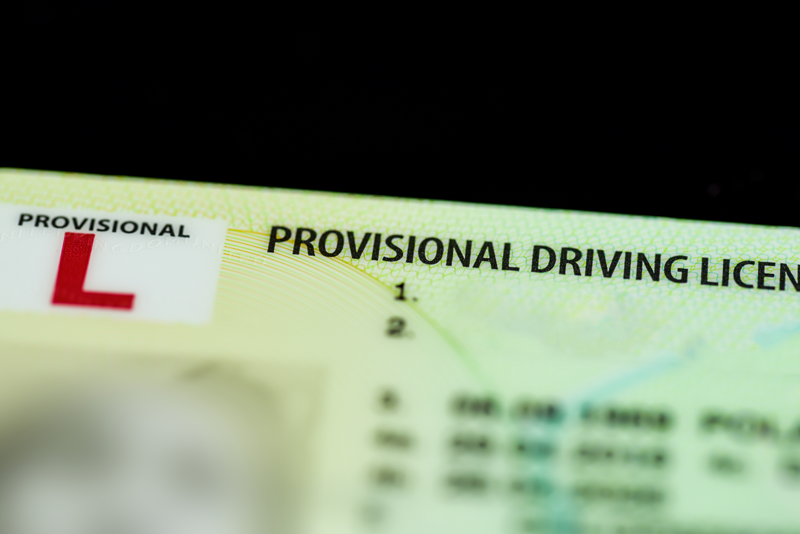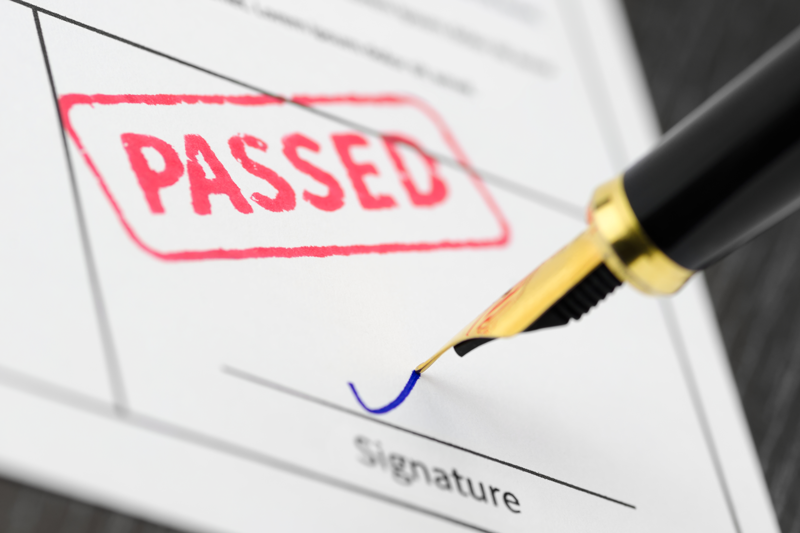There are 50 car theory test questions on which a test candidate will be expected to answer on the actual car theory test. The test candidate will need to answer a minimum of 43 questions correctly to pass this section of the theory test. Once this part is complete, they will move on to the hazard perception part of the test. For this part of the car theory test, the test candidate will watch 14 video clips all with at least 1 hazard (potentially dangerous situation) included. Thirteen of the hazard perception video clips has a maximum scoring of 5 points each and one of the hazard perception video clips has a double hazard added, so this video clip has a maximum of 10 points. The maximum score you can receive for the hazard perception part of the car theory test is 75 points with a minimum of 44 points needed to pass this section. The final part of the car theory test is the new video case studies. The test candidate will be asked to watch a short video and will be expected to answer 3 multiple choice questions regarding the short video. These video case studies have replaced the previous case studies where you had to read a case study and answer 5 questions about what you just read.
Helpful ways to revise for the car theory test
You can choose to either purchase car theory test software online or purchase a car theory test book, but the soundest advice is that whichever method you have chosen to study and practice for the car theory test you should always give yourself plenty of study time.

Many learner drivers underestimate the amount of study time required for the car theory test and this is one of the reasons why the pass rate is so low. This is likely to be because many learner drivers notice that some of the theory test questions may seem a bit obvious. Below are a few examples:
What should you do if your mobile phone rings while you’re driving or riding?
- Stop immediately
- Answer it immediately
- Leave it until you have stopped in a safe place
- Pull up at the nearest kerb
Well, you probably have guessed that the correct answer is
- Leave it until you have stopped in a safe place.
There are many other questions that are not so obvious, see below…
How can you avoid a wheelspin when you’re driving on an icy road?
- Drive at a slow speed in the highest gear possible
- Use the parking brake if the wheels start to slip
- Brake gently and repeatedly
- Drive in a low gear at all times
The two most common answers here that most test candidates seem to opt for is:
- Use the parking brake if the wheels start to slip
- Brake gently and repeatedly
Both may seem to be viable options as when the cars wheels are spinning, and the driver is starting to lose control then they should slow the car down but unfortunately braking on an icy road can cause the wheels to skid even more making the car lose more traction. Therefore, the correct answer is:
- Drive at a slow speed in the highest gear possible
The simple reason to this is that higher gears make the wheels spin round slower which gives the wheels more chance of gaining friction on the ice compared to the lower gears where they make the wheels spin round faster which in return is more likely to cause the wheels to lose friction/ grip on the ice possibly resulting in the car losing control. Just imagine, it has snowed, and the pavement is icy. Would you run or slowly walk? Of course, you would walk as you are more likely to slip and fall down if you run on ice.
How to book the car theory test and what is needed on the day?
Booking the car theory test can be done in two ways. You can either book the car theory test online by using the gov.uk website or you can book the car theory test by calling the DVSA on 0300 200 1122. It is a lot easier and quicker to book the car theory test online as you can do it at any time of the day and without the need of being on hold until someone answers the phone. The cost of the car theory test is £23, and you will need your provisional licence number in order to book the car theory test.

On the day of the car theory test you will need to produce your provisional licence to the receptionists at the test centre as they will need to perform their security check to ensure that it is you on the licence. If you happen to only have the old paper part of the provisional licence, then you will need to have your passport with you as the receptionists at the car theory test centre will need to see some sort of photo ID before allowing you to take the car theory test. In the past, it was not uncommon for candidates to send someone else to take their theory test for them – so stringent checks have now been put in place.
Can I take the car theory test in my native language?

You can only take the car theory test in either English, Welsh, or British Sign Language (BSL). You do not have an option to take the car theory test in any other language. If you choose to take the car theory test in BSL you can either have an on-screen interpreter or you can request an interpreter from the DVSA. You must let the DVSA know before you book the car theory test that you wish to have an interpreter on the day and they will arrange one for you. You cannot just bring your own interpreter as each interpreter needs to be previously vetted and to be on the DVSA’s list of approved BSL interpreters. The best way to arrange an interpreter for the car theory test is to call the DVSA up directly. This is not always practical for Deaf or Hard of Hearing people so they will need to ask a hearing person to do this for them. By calling the DVSA to arrange a BSL interpreter for the car theory test, the contact centre staff will usually ask which date the test candidate has in mind, then take the payment of £23 and then they will email the test candidate with suitable dates that the BSL interpreter is free on. Once a suitable date is confirmed, the Deaf or Hard of Hearing candidate will have their interpreter booked, will be given an additional 40 minutes and will normally be given a private room with the interpreter where possible. By booking the car theory test online the Deaf or Hard or Hearing candidate may not receive all the above.
When should I take the take car theory test?
This is a question only the test candidate can decide but we will give you some suggestions on when the best time to take the car theory test normally is. If you take the car theory test whilst having driving lessons and manage to pass the theory test before you are ready to book the practical test, then that is great. If you end up failing the theory test or it gets cancelled and you have to take another theory test, then you might find yourself in a situation where you are nearly ready for the practical driving test but still haven’t passed the car theory test. Unfortunately, you cannot book or take your practical driving test until you have passed the car theory test. This situation will inevitably force you into two outcomes: you either carry on taking driving lessons in order not to forget what you have learnt on your driving lessons knowing that you are spending more money on lessons that you do not really need, or you will end up stopping your driving lessons until you have passed the car theory test possibly resulting in forgetting a lot of the skills and knowledge you learnt whilst learning to drive.

It is a difficult one, but we tend to suggest that it is always a good idea that learner drivers pass the car theory test before they start their driving lessons. This way the learner driver has one less thing to worry about, plus they have two years in which to pass their practical driving test before their theory test will expire. As the average learner driver needs around 4 – 6 months of driving lessons before they are ready for their practical driving test, this solution tends to work for most theory test candidates.
Can I take the theory test anywhere else other than the test centre?
You can practice and revise for the car theory test as much as you like at home, on your travels or with friends but when it comes to the day of your car theory test then you will need to take the car theory test at a theory test centre, preferably the nearest one to your home.

Imagine if learner drivers were allowed to take the real car theory test at home, who would be able to monitor them and how can the DVSA ensure that there was no help involved to answering any of the theory test questions, hazard perception or video case studies. There would be a huge increase in pass rates and many new drivers would be less knowledgeable of the rules of the road.
New Video Clips and when and why they came about
From 28th September 2020, the car theory test now includes a short video that test candidates will need to watch and then they will need to answer 3 questions relating to what they witnessed in the video. The video will be related to driving and there will be hazards along the journey that the test candidate will need to be aware of.

These video case studies were due to come into force on the 14th April 2020 but arrived five and a half months late due to the Coronavirus pandemic and the impacts it has had on the UK. Before this, a test candidate had to read a case study and then answer five questions regarding the case study. The main reason for the change from reading the case study to watching a short video clip was that the DVSA wanted to make the car theory test more accessible to Deaf, Hard of Hearing, Autistic and Dyslexic people and anyone that has any type of learning difficulty. This makes the car theory test more visual and to be more inclusive to all theory test candidates.
Car theory test facts January 2021:
- The actual car theory test can only be taken at a designated theory test centre and not at home
- There are 730 car theory test questions that need to be revised as well as the hazard perception videos and video case studies
- There are 14 car theory test subjects that need to revised from Alertness to Vulnerable Road Users
- Test candidates need a minimum score of 43 out of 50 on the car theory test questions and a minimum score of 44 out of 75 on the hazard perception videos to pass the car theory test
- The pass rate for the car theory test is currently at around 48%
- The theory test pass certificate lasts for 2 years and the learner driver will need to pass their practical driving test before their theory test expires otherwise, they will need to re-sit their theory test
- The previous case study has been replaced by the new video case study as part of the car theory test exam

Summary of the car theory test
Its clear that the car theory test has been developed to be challenging but the idea behind it all was that it would be informative and help the learner driver understand the risks and dangers of driving as well as its rewards. Spend sufficient time learning, understanding, and revising for the car theory test as not only would it cost you £23 every time you need to re-sit the theory test, but it can be quite demeaning and demoralising to keep re-sitting the test as well as a constant hassle. Use this time as an opportunity to learn all about the UK roads, signs, traffic orders and procedures and ensure that when you do pass both the car theory test and the practical driving test that you will be a safe driver on todays UK roads. A good road user does not just drive safely but they anticipate what other road users may do and that way they can always plan ahead.


